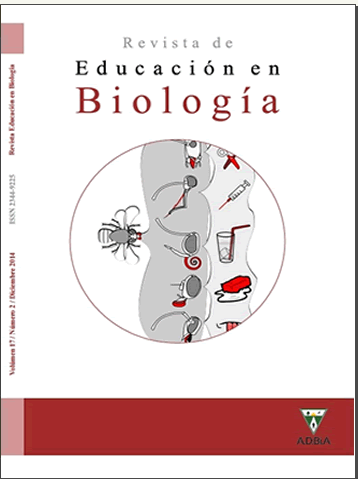A New Approach for Systematic Botany Teaching in Biology Teaching Training in Córdoba City
Main Article Content
Abstract
The general purpose of this Master Thesis was to formulate and analyze an innovative proposal in Systematic Botany teaching, comparing the students’ achievements to another group with similar characteristics in which the innovation was not applied. The Institutes where this project was carried out were:”Nuestra Madre de la Merced” Biology Teaching Training School from Cordoba City (experimental group) and Biology Teaching Training School from the National University of La Rioja, Chepes (control
group). The work methodology focused on the comparative analysis between the two groups. The formulated hypothesis states that those students who participate in a Systematic Botany teaching proposal with a biodiversity problem-raising approach achieve a better level of interpretation of concepts and have more chances of transferring what they have learnt to new educational situations. From the analysis conducted,
we can highlight that the innovation that was implemented has been successful in relation to the formulated hypothesis, as changes have been observed in the traditional teacher-students relationship, as well as a good level of understanding of concepts, the development of self-management of knowledge about plants and the incorporation of methodological tools for their future work as high school teachers. Therefore, students had the opportunity to participate in a new form of learning-teaching in which they were responsible for the research, discussion and synthesis of the available information.
group). The work methodology focused on the comparative analysis between the two groups. The formulated hypothesis states that those students who participate in a Systematic Botany teaching proposal with a biodiversity problem-raising approach achieve a better level of interpretation of concepts and have more chances of transferring what they have learnt to new educational situations. From the analysis conducted,
we can highlight that the innovation that was implemented has been successful in relation to the formulated hypothesis, as changes have been observed in the traditional teacher-students relationship, as well as a good level of understanding of concepts, the development of self-management of knowledge about plants and the incorporation of methodological tools for their future work as high school teachers. Therefore, students had the opportunity to participate in a new form of learning-teaching in which they were responsible for the research, discussion and synthesis of the available information.
Article Details
How to Cite
A New Approach for Systematic Botany Teaching in Biology Teaching Training in Córdoba City. (2014). Journal of Biology Education, 17(2), (pp. 118-121). https://doi.org/10.59524/2344-9225.v17.n2.22443
Section
Tesis

This work is licensed under a Creative Commons Attribution-NonCommercial-ShareAlike 4.0 International License.
Aquellos autores/as que tengan publicaciones con esta revista, aceptan los términos siguientes:- Los autores/as conservarán sus derechos de autor y garantizarán a la revista el derecho de primera publicación de su obra, el cuál estará simultáneamente sujeto a la Licencia de reconocimiento de Creative Commons que no se permite un uso comercial de la obra original ni de las posibles obras derivadas, la distribución de las cuales se debe hacer con una licencia igual a la que regula la obra original.
- Los autores/as podrán adoptar otros acuerdos de licencia no exclusiva de distribución de la versión de la obra publicada (p. ej.: depositarla en un archivo telemático institucional o publicarla en un volumen monográfico) siempre que se indique la publicación inicial en esta revista.
- Se recomienda a los autores/as difundir su obra a través de Internet (p. ej.: en archivos telemáticos institucionales o en su página web) después del proceso de publicación, lo cual puede producir intercambios interesantes y aumentar las citas de la obra publicada. (Véase El efecto del acceso abierto).
How to Cite
A New Approach for Systematic Botany Teaching in Biology Teaching Training in Córdoba City. (2014). Journal of Biology Education, 17(2), (pp. 118-121). https://doi.org/10.59524/2344-9225.v17.n2.22443

